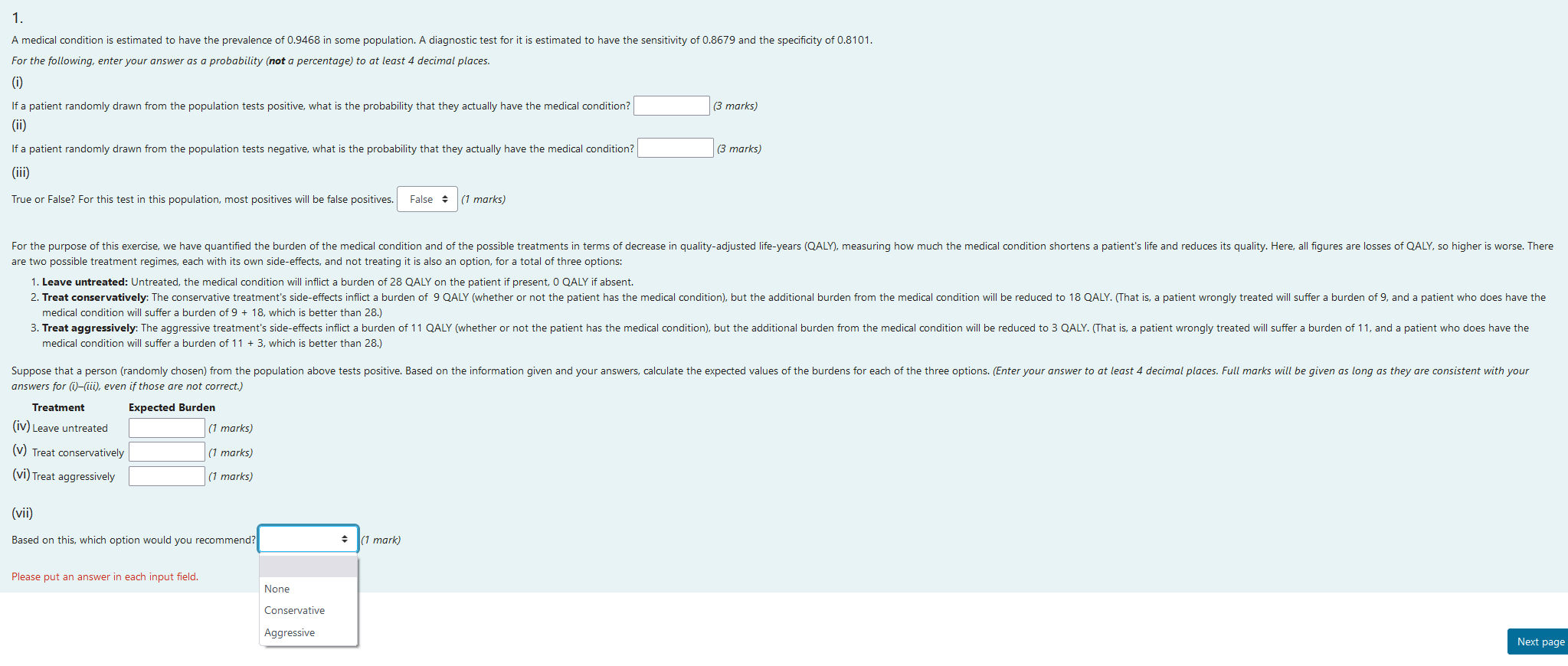
1. A medical condition is estimated to have the prevalence of 0.9468 in some population. A diagnostic test for it is estimated to have the sensitivity of 0.8679 and the specificity of 0.8101. For the following, enter your answer as a probability (not a percentage) to at least 4 decimal places. (0) If a patient randomly drawn from the population tests positive, what is the probability that they actually have the medical condition? (3 marks) (ii) If a patient randomly drawn from the population tests negative, what is the probability that they actually have the medical condition? (3 marks) (iii) True or False? For this test in this population, most positives will be false positives. False (1 marks) For the purpose of this exercise, we have quantified the burden of the medical condition and of the possible treatments in terms of decrease in quality-adjusted life-years (QALY), measuring how much the medical condition shortens a patient's life and reduces its quality. Here, all figures are losses of QALY, so higher is worse. There are two possible treatment regimes, each with its own side-effects, and not treating it is also an option, for a total of three options: 1. Leave untreated: Untreated, the medical condition will inflict a burden of 28 QALY on the patient if present, O QALY if absent. 2. Treat conservatively: The conservative treatment's side-effects inflict a burden of 9 QALY (whether or not the patient has the medical condition), but the additional burden from the medical condition will be reduced to 18 QALY. (That is, a patient wrongly treated will suffer a burden of 9, and a patient who does have the medical condition will suffer a burden of 9 + 18, which is better than 28.) 3. Treat aggressively: The aggressive treatment's side-effects inflict a burden of 11 QALY (whether or not the patient has the medical condition), but the additional burden from the medical condition will be reduced to 3 QALY. (That is, a patient wrongly treated will suffer a burden of 11, and a patient who does have the medical condition will suffer a burden of 11 + 3, which is better than 28.) Suppose that a person (randomly chosen) from the population above tests positive. Based on the information given and your answers, calculate the expected values of the burdens for each of the three options. (Enter your answer to at least 4 decimal places. Full marks will be given as long as they are consistent with your answers for ((-(iii), even if those are not correct.) Treatment Expected Burden (iv) Leave untreated (1 marks) (v) Treat conservatively (1 marks) (vi) Treat aggressively (1 marks) (vii) Based on this, which option would you recommend? (1 mark) Please put an answer in each input field. None Conservative Aggressive Next page 1. A medical condition is estimated to have the prevalence of 0.9468 in some population. A diagnostic test for it is estimated to have the sensitivity of 0.8679 and the specificity of 0.8101. For the following, enter your answer as a probability (not a percentage) to at least 4 decimal places. (0) If a patient randomly drawn from the population tests positive, what is the probability that they actually have the medical condition? (3 marks) (ii) If a patient randomly drawn from the population tests negative, what is the probability that they actually have the medical condition? (3 marks) (iii) True or False? For this test in this population, most positives will be false positives. False (1 marks) For the purpose of this exercise, we have quantified the burden of the medical condition and of the possible treatments in terms of decrease in quality-adjusted life-years (QALY), measuring how much the medical condition shortens a patient's life and reduces its quality. Here, all figures are losses of QALY, so higher is worse. There are two possible treatment regimes, each with its own side-effects, and not treating it is also an option, for a total of three options: 1. Leave untreated: Untreated, the medical condition will inflict a burden of 28 QALY on the patient if present, O QALY if absent. 2. Treat conservatively: The conservative treatment's side-effects inflict a burden of 9 QALY (whether or not the patient has the medical condition), but the additional burden from the medical condition will be reduced to 18 QALY. (That is, a patient wrongly treated will suffer a burden of 9, and a patient who does have the medical condition will suffer a burden of 9 + 18, which is better than 28.) 3. Treat aggressively: The aggressive treatment's side-effects inflict a burden of 11 QALY (whether or not the patient has the medical condition), but the additional burden from the medical condition will be reduced to 3 QALY. (That is, a patient wrongly treated will suffer a burden of 11, and a patient who does have the medical condition will suffer a burden of 11 + 3, which is better than 28.) Suppose that a person (randomly chosen) from the population above tests positive. Based on the information given and your answers, calculate the expected values of the burdens for each of the three options. (Enter your answer to at least 4 decimal places. Full marks will be given as long as they are consistent with your answers for ((-(iii), even if those are not correct.) Treatment Expected Burden (iv) Leave untreated (1 marks) (v) Treat conservatively (1 marks) (vi) Treat aggressively (1 marks) (vii) Based on this, which option would you recommend? (1 mark) Please put an answer in each input field. None Conservative Aggressive Next page







